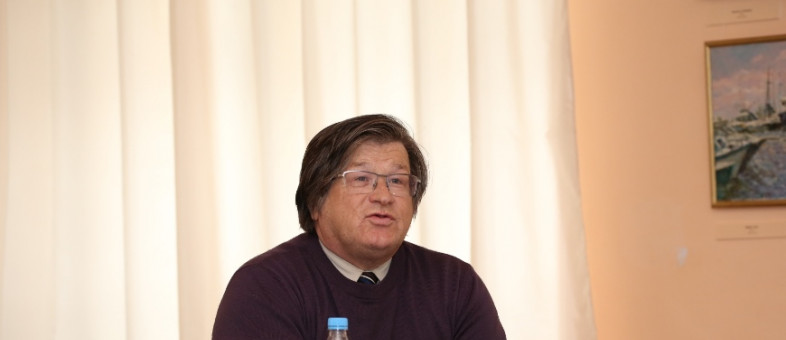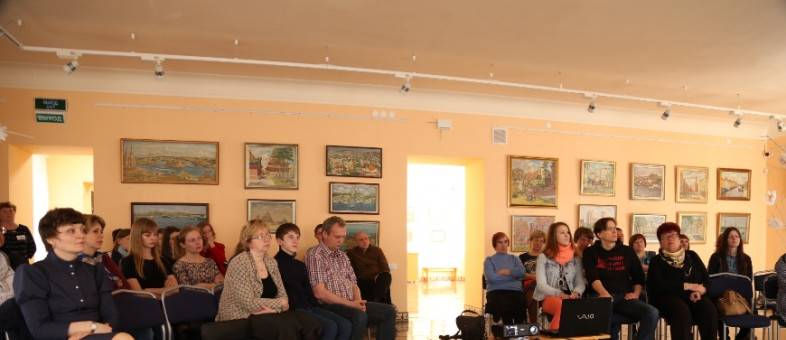Director of Kirillo-Belozersky Museum-Reserve opened “Night at the Museum” in Kirillov
Director of the Kirillo-Belozersky Museum-Reserve M.N. Sharomazov opened “Night at the Museum” in Kirillov.
On May 18, 2017
On the International Museum Day, residents of Kirillov could get to the foot of Mount Vesuvius, to go for a walk in Pompeii and Herculaneum and to go back to August 24, 79 AD, when the volcano erupted after 800 years of silence.
Mikhail Sharomazov, director of the Kirillo-Belozersky Museum-Reserve, told the audience about the history of the ancient Roman towns in the People’s House on May 18. He retraced the history of the happened disaster in detail by the example of the canvas “The Last Day of Pompeii” painted by Karl Bryullov.
“Pompeii was a town that had an impact on the European culture of the second half of the 18th century. The eruption of Mount Vesuvius on August 24, 79 AD, destroyed Pompeii and Herculaneum, buried plenty of coastal towns under volcanic ash. This area was abandoned for some time after that. They made some attempts to change the situation for the better under the emperor, but couldn’t do anything. It was impossible to live on the site of the town. Nevertheless, it didn’t disappear from the maps of the Middle Ages.
In the 16th century, digging an underground channel through Pompeii, they came across ancient walls covered with paintings and inscriptions. Real excavations began there in 1748. The Europeans were amazed with the first finds – perfect works of pagan art, applied art. The rediscovery of Pompeii made people understand that the art of the late 18th century was overflowing with Baroque heritage and was overloaded with composition in comparison with those masterpieces that were unearthed. Pompeii unveiled the whole civilization, the whole world that was unknown”, explained M.N. Sharomazov.
Slides of the presentation alternated and the audience could see pictures of modern narrow streets of Pompeii, nature of surpassing beauty, thermae, places where the patricians used to build their villas, the Temple of Apollo found during the excavations of Pompeii… and Mount Vesuvius! Its eruption, remains of people who died under layers of hot ash fallen on the town in a matter of seconds. M.N. Sharomazov continued reading his lecture, “Many figures in the canvas of Briullov “The Last Day of Pompeii” are depicted in those poses that the artist saw himself walking along the streets of the ancient town – a mother with children, a woman fallen off the chariot, a young couple… Karl Briullov gathered material for a long time, visited Pompeii several times, examined the houses, walked along the streets, and made sketches of the imprints of human bodies. We can see a real tragedy here. Residents of the town hoped that they would be saved if they went through the sea gate. But it was impossible. The letters of Pliny the Younger, political figure of Ancient Rome, have come down to us. He wrote that the lava of the volcano reached the sea, it began to boil and everybody who was there boiled”.
M.N. Sharomazov told about the architecture of Ancient Rome and history painting in the context of Karl Briullov’s creative work, “To make the composition dense, the artist upsets the real correlations: he visually moves Mount Vesuvius nearer, dismantles the temple and makes the composition dynamic. Nevertheless, he couldn’t create a single composition in this picture in spite of richness of scenic relations and originality of light solutions. It was probably a certain solution (not to include separate groups of elements into a single whole) that can be seen in his latest works. The subject of the painting “The Last Day of Pompeii” is unusual; it connects the topics of destruction and human self-sacrifice. We can see death here, the end that has no future… And the opposition of paganism and Christianity at the same time. The only person who is happy with everything that is taking place is dancing Faunus who watches the decline of the pagan world conceiving it as renaissance and absolution from sins”.
“The Last Day of Pompeii” became the first event that was held in Kirillov within the framework of the International Action “Night at the Museum”. An interesting cultural program will be organized for you in the Museum of Town and District History and in the Kirillo-Belozersky Museum-Reserve tomorrow. It is time not to sleep!
Official name of the museum:
The Federal State Budgetary Institution of Culture “Kirillo-Belozersky Historical, Architectural and Art Museum-Reserve”
Founded:
In 1924
Museum status:
It was included into the State List of Particularly Valuable Objects of Cultural Heritage of the Peoples of the Russian Federation in 1997.

 найти на плане
найти на плане



